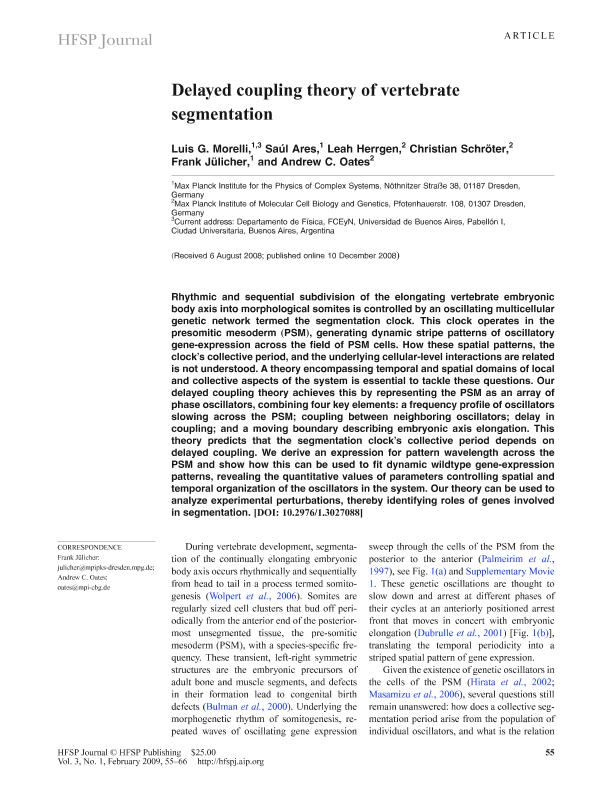Mostrar el registro sencillo del ítem
dc.contributor.author
Morelli, Luis Guillermo

dc.contributor.author
Ares, Saúl
dc.contributor.author
Herrgen, Leah
dc.contributor.author
Schröter, Christian
dc.contributor.author
Jülicher, Frank
dc.contributor.author
Oates, Andrew C.

dc.date.available
2018-09-20T17:16:50Z
dc.date.issued
2009-12
dc.identifier.citation
Morelli, Luis Guillermo; Ares, Saúl; Herrgen, Leah; Schröter, Christian; Jülicher, Frank; et al.; Delayed coupling theory of vertebrate segmentation; Hfsp Publishing; Hfsp Journal; 3; 1; 12-2009; 55-66
dc.identifier.issn
1955-2068
dc.identifier.uri
http://hdl.handle.net/11336/60461
dc.description.abstract
Rhythmic and sequential subdivision of the elongating vertebrate embryonic body axis into morphological somites is controlled by an oscillating multicellular genetic network termed the segmentation clock. This clock operates in the presomitic mesoderm (PSM), generating dynamic stripe patterns of oscillatory gene-expression across the field of PSM cells. How these spatial patterns, the clock's collective period, and the underlying cellular-level interactions are related is not understood. A theory encompassing temporal and spatial domains of local and collective aspects of the system is essential to tackle these questions. Our delayed coupling theory achieves this by representing the PSM as an array of phase oscillators, combining four key elements: a frequency profile of oscillators slowing across the PSM; coupling between neighboring oscillators; delay in coupling; and a moving boundary describing embryonic axis elongation. This theory predicts that the segmentation clock's collective period depends on delayed coupling. We derive an expression for pattern wavelength across the PSM and show how this can be used to fit dynamic wildtype gene-expression patterns, revealing the quantitative values of parameters controlling spatial and temporal organization of the oscillators in the system. Our theory can be used to analyze experimental perturbations, thereby identifying roles of genes involved in segmentation. © HFSP Publishing.
dc.format
application/pdf
dc.language.iso
eng
dc.publisher
Hfsp Publishing

dc.rights
info:eu-repo/semantics/openAccess
dc.rights.uri
https://creativecommons.org/licenses/by-nc-sa/2.5/ar/
dc.subject
Vertebrate Segmentation
dc.subject
Coupled Oscillators
dc.subject
Coupling Delays
dc.subject.classification
Otras Ciencias Biológicas

dc.subject.classification
Ciencias Biológicas

dc.subject.classification
CIENCIAS NATURALES Y EXACTAS

dc.title
Delayed coupling theory of vertebrate segmentation
dc.type
info:eu-repo/semantics/article
dc.type
info:ar-repo/semantics/artículo
dc.type
info:eu-repo/semantics/publishedVersion
dc.date.updated
2018-09-18T16:30:06Z
dc.journal.volume
3
dc.journal.number
1
dc.journal.pagination
55-66
dc.journal.pais
Francia

dc.journal.ciudad
Strasbourg
dc.description.fil
Fil: Morelli, Luis Guillermo. Universidad de Buenos Aires; Argentina. Consejo Nacional de Investigaciones Científicas y Técnicas. Oficina de Coordinación Administrativa Ciudad Universitaria. Instituto de Física de Buenos Aires. Universidad de Buenos Aires. Facultad de Ciencias Exactas y Naturales. Instituto de Física de Buenos Aires; Argentina
dc.description.fil
Fil: Ares, Saúl. Max Planck Institute For The Physics Of Complex Systems; Alemania
dc.description.fil
Fil: Herrgen, Leah. Max Planck Institute Of Molecular Cell Biology And Genetics; Alemania
dc.description.fil
Fil: Schröter, Christian. Max Planck Institute Of Molecular Cell Biology And Genetics; Alemania
dc.description.fil
Fil: Jülicher, Frank. Max Planck Institute For The Physics Of Complex Systems; Alemania
dc.description.fil
Fil: Oates, Andrew C.. Max Planck Institute Of Molecular Cell Biology And Genetics; Alemania
dc.journal.title
Hfsp Journal

dc.relation.alternativeid
info:eu-repo/semantics/altIdentifier/doi/http://dx.doi.org/10.2976/1.3027088
Archivos asociados
